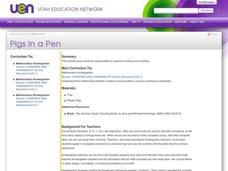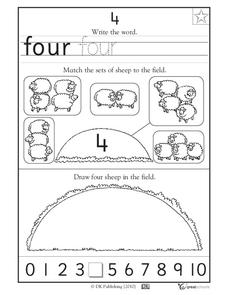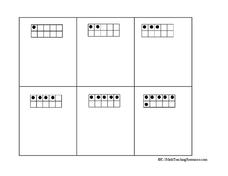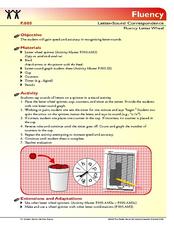Perkins School for the Blind
Stuff, Seal and Stamp Mail
Have your class practice functional skills that can be applied to a wide variety of job opportunities. They will use a folding jig to help them fold, stuff, seal, stamp, and mail letters. Students with visual impairments will build...
Curated OER
Grab a Handful and Count
Let's use Fruit Loops to teach counting skills! Students practice counting one-to-one correspondence using Fruit Loops with a partner and then compare them to see who has more or less.
Curated OER
Pigs in a Pen
Kindergarteners explore numbers, counting, and one-to-one correspondence. Through demonstrations and hands on activities using math manipulatives, they discover several number concepts as well as practice counting throught rote...
Curated OER
Odd One Out
Practice lowercase letters i-n with this initial sounds worksheet. There is a row of three objects for each of these letters, and scholars examine them to determine which does not begin with the letter sound. This would work best with...
Curated OER
Odd One Out
There is one object that doesn't belong in each of these sets. Scholars circle the one that doesn't rhyme, listening for the /o/ vowel sound (long and short) in the others. They connect two of the objects to printing practice,...
CK-12 Foundation
Existence: One-to-One Functions and Inverses
One-to-one means the answer is simple, right? Given four graphs, pupils use a vertical line to test each graph to find out if they are one-to-one. By using the resource, learners realize that not all one-to-one relations are functions....
Institute for Teaching through Technology and Innovative Practices
The Right Number of Elephants
How can you tell if a number of items is reasonable? Combine math and language arts with a fun lesson based on Jeff Shepard's The Right Number of Elephants. After reading the book, kids discuss amounts of other items and create...
BW Walch
Creating and Graphing Linear Equations in Two Variables
This detailed presentation starts with a review of using key components to graph a line. It then quickly moves into new territory of taking these important parts and teasing them out of a word problem. Special care is...
Inside Mathematics
Two Solutions
Many problems in life have more than one possible solution, and the same is true for advanced mathematics. Scholars solve seven problems that all have at least two solutions. Then three higher-level thinking questions challenge them to...
DK Publishing
Learning 4 - Write the Word
Focus on the number four as youngsters complete several exercises to solidify this number concept. Note pre-readers will have a hard time with this, as it requires reading instructions. Consider doing together as a class or...
K-5 Math Teaching Resources
Numeral Cards 1-12
The learning opportunities are endless with these numeral cards representing numbers one through twelve. With a clean and clear design, you have flexibility in how and when you choose to implement them.
K-5 Math Teaching Resources
Ten Frame Cards
Support your visual learners on their journey to mathematical understanding with this collection of ten frame cards. Representing numbers from 1 to 42, these pictures can be used in any number of ways to introduce children to the concept...
Curated OER
One of Our Five Senses - Touch
The wonderful world of Oobleck is entered in order to awaken your learner's sense of touch! As a warm up, learners put their hands in mystery bags in order to identify things that are wet, dry, hot, cold, hard, soft, rough, and smooth....
Oregon Department of Education
Building Number Sense
It's never too early to begin a child's math education. This collection of fun hands-on activities engage youngsters in building their number sense as they learn how to count objects, identify numerals, compare amounts, and much more.
EngageNY
Using Sample Data to Compare the Means of Two or More Populations
Determine whether there is a difference between two grades. Teams generate random samples of two grade levels of individuals. Groups use the mean absolute deviation to determine whether there is a meaningful difference between the...
Houghton Mifflin Harcourt
Unit 4 Math Vocabulary Cards (Grade 1)
Support math vocabulary using a set of 25 flashcards. The set consists of a variety of bold-faced word cards and corresponding labeled picture cards. Terms include even numbers, regrouping, skip counting, and more.
EngageNY
Close Reading: Unpacking Specific Articles of the UDHR
Lesson 6 of this extensive unit finally has your class begin to work their way through specific articles from the text of the Universal Declaration of Human Rights (UDHR). Before examining the rights actually detailed in the...
Curated OER
The Counting Caterpillar
A daily counting routine builds a caterpillar with 100 body segments (marked with symbols to indicate 2s, 5s, and 10s) by the 100th day of school. Provides structured repetition as part of the morning routine so that by 100th day,...
Curated OER
Number Lines and Whole Numbers
Use number lines to visually represent addition and subtraction equations. First, scholars complete an addition number sentence and represent the equation on a number line. Next, they examine a number line and write the corresponding...
Curated OER
Investigation - Patterns/Functions
Students explore one-to-one correspondence. Through activities, students examine rhythm and patterns. From the patterns discovered, students create a visual representation of the pattern with blocks.
Florida Center for Reading Research
Phonics: Letter-Sound Correspondence, Letter-Sound Bingo
Young scholars build a strong understanding of medial sounds, vowels, and letter sound correspondence while playing Bingo. Taking turns, peers choose a card and say its name and medial sound; all players look for the vowel on their card....
Florida Center for Reading Research
Phonics: Letter- Sound Correspondence, Brown Bag It
Sorting objects according to their initial sound get scholars thinking about letter-sound correspondence. With 26 brown bags labeled with a letter of the alphabet, learners browse magazines and cut out images that begin with the...
Florida Center for Reading Research
Fluency: Letter-Sound Correspondence, Fluency Letter Wheel
Young scholars spin their way to letter sound fluency. While tomes, pairs spin a spinner and make the sound of the letter on which it lands. They add a counter to their cup for each sound they make correctly. At the end of the game,...
Florida Center for Reading Research
Phonics: Letter-Sound Correspondence, Letter-Sound Pyramid
This fun game is a way to help your littlest learners build strong phonological awareness. Scholars equipped with letter triangles, a stack of picture cards, and counters choose a picture card, say the name of the image, and attempt to...

























